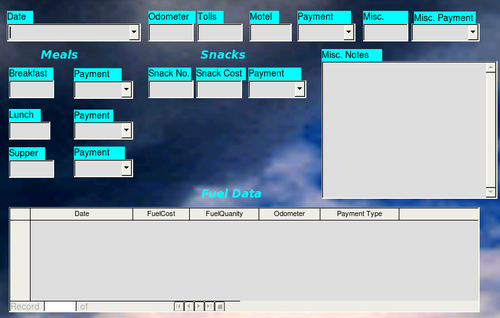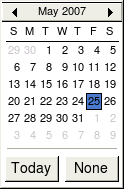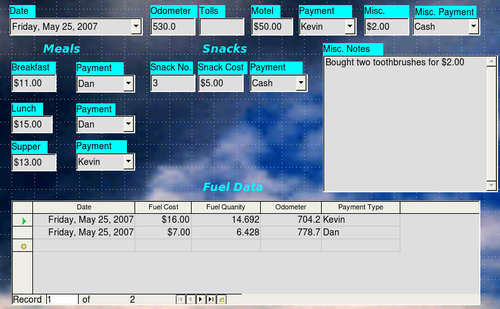Entering data in a form
Records are used to organize the data we enter into a form. They also organize the data we enter into a subform.
Each type of field allows a different method to enter the data. In most if not all cases, more than one method can be used.
The first step to entering data in a form is to open it from the main database window.
- Click the Forms icon in the Database list.
- Find the form's name in the Forms list (Vacations).
- Double-click the form's name.
The quickest way to enter a date in the Date field is to click the arrow that opens the dropdown calendar. Then click the date you want. Use the Tab key to go to the Odometer field.
- Click the left arrow before May to go back one month (April 2007).
- Click the right arrow after 2007 to go forward one month (June 2007).
- Multiple clicks in either direction will change the month and year the same number of times as the number of clicks.
The Odometer, Tolls, and Motel fields are numerical fields. Enter values directly into them, or use the up and down arrows. When the value is entered, use the Tab key to go to the next field.
- The up arrow increases the value, and the down arrow decreases the value.
- These two arrows only change the numerals to the left of the decimal place.
- Numerals to the right of the decimal place must be changed by deleting them and typing the desired ones.
The Motel's Payment field is a dropdown list. If as in my case, all of the elements of the list start with different letters, typing the first letter will select the desired letter.
- If two or more elements of the list have the same first letter, repeated typing of the first letter will cycle through the elements with this same first letter. So, if you accidentally go past the the element you wanted, you can keep typing the first letter until it reappears again.
- When the selection is correct, use the Tab key to go to the Misc. field.
The rest of the fields of the main form are either numerical fields or dropdown lists until we reach the Misc. Notes field. It is a text field. Type anything you desire in this field just as you would any simple text editor.
Since we have a subform form, using the Tab key places the cursor in the first Date field of the subform with the date automatically entered to match the Date field of the main form.
The FuelCost, FuelQuanity, and Odometer fields are numerical fields. The Payment field is a dropdown list. Enter the data just as you did in the main form, and use the Tab key to go to the next field.
When you use the Tab key to leave the Payment field, it goes to the Date field of the next line and automatically enters the date. Now you can enter your second set of fuel data for this day.
To move to another record when the form has a subform, the directional arrows at the bottom must be use. There are four of them from left to right: First Record, Previous Record, Next Record, and Last Record (Figure 64). To the right of these arrows in the New Record icon.
To create a new record while in another record, click the New Record icon. Two choices exist for creating a new record following the present record:
- Click the Next Record icon.
- Or, click the New Record icon.
Below is a record with data inserted in its fields. Note that not all fields have data in them. It is only necessary to have data in every field if you determine ahead of time to require all fields contain data.
| Content on this page is licensed under the Creative Common Attribution 3.0 license (CC-BY). |


